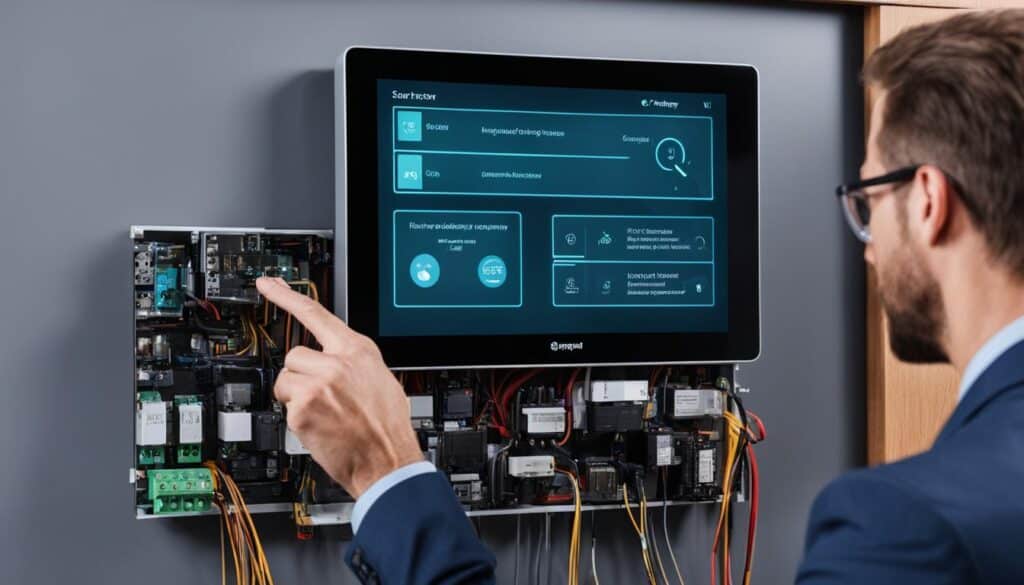Smart home automation has revolutionized the way we live, offering convenience, efficiency, and peace of mind. However, as a beginner, the prospect of troubleshooting smart home issues can be overwhelming. Fear not, for I am here to guide you through the maze of automation and help you overcome any challenges that come your way.
Whether it’s connecting devices, ensuring compatibility, or resolving software glitches, I’ll provide you with the knowledge and tips you need to troubleshoot your smart home system effectively. By the end of this article, you’ll be equipped with the skills to navigate your connected haven with ease and confidence.
So, let’s dive in and explore the world of smart home troubleshooting for beginners!
Table of Contents
Key Takeaways:
- Smart home automation offers convenience, efficiency, and peace of mind.
- Troubleshooting smart home issues can be overwhelming for beginners.
- This article will provide comprehensive guidance for troubleshooting smart home systems.
- Connectivity problems, device compatibility issues, and software glitches are common smart home challenges.
- By following the tips and solutions provided, beginners can overcome these challenges and enjoy a fully functional smart home system.
Common Smart Home Issues and Solutions
As a beginner with smart home systems, you may encounter a few common issues that can hinder the seamless operation of your connected haven. Let’s explore these smart home issues and discover practical solutions to resolve them effectively.
Connectivity Problems
One of the most prevalent challenges in smart home systems is connectivity problems. These issues can disrupt communication between your devices and compromise their functionality. Some common connectivity problems include:
- Wi-Fi connectivity dropouts
- Network configuration issues
To address these connectivity issues, follow these steps:
- Check your Wi-Fi signal strength and ensure your devices are within range.
- Reset your Wi-Fi router and reconnect your devices to establish a fresh connection.
- Make sure you have entered the correct network credentials when setting up your devices.
By troubleshooting these connectivity problems, you can enjoy a stable and reliable connection for your smart home devices.
Device Compatibility Issues
Another common smart home issue is device compatibility. Not all smart home devices are designed to work seamlessly together, which can result in compatibility conflicts and non-responsive devices. Here are some steps to resolve device compatibility issues:
“Compatibility is crucial in creating a harmonious smart home ecosystem. Ensure your devices are compatible and capable of communicating with each other for optimal performance.”
- Consult the device manuals or manufacturer’s website to determine compatibility requirements.
- Research and invest in devices that are known to work well together within the same ecosystem.
- If facing persistent compatibility issues, consider using a smart home hub or bridge to facilitate communication between devices.
By addressing these device compatibility issues, you can build a cohesive smart home system that operates smoothly and efficiently.
Unresponsive Devices and Software Glitches
In addition to connectivity and compatibility issues, you may also encounter unresponsive devices and software glitches. These problems can be frustrating but can often be resolved by following these steps:
“When your devices become unresponsive or encounter software glitches, try these troubleshooting tips to get them back on track.”
- Restart the unresponsive device by unplugging it and plugging it back in.
- Ensure your device’s firmware and software are up to date by checking for updates through the manufacturer’s app or website.
- If the problem persists, reset the device to its factory settings, following the manufacturer’s instructions.
By addressing these common smart home issues and implementing the suggested solutions, you can overcome challenges and enjoy a fully functional smart home system.
Next, we’ll focus on troubleshooting connectivity problems commonly encountered in smart home systems.
Troubleshooting Connectivity Problems
Connectivity problems are a common culprit behind issues in smart home systems. When your devices can’t communicate effectively, it can cause frustration and hinder the seamless automation experience you desire. In this section, I’ll dive into the various connectivity issues you may encounter and provide troubleshooting tips to help you identify and resolve them.
Wi-Fi Connectivity Problems
Wi-Fi connectivity is essential for the smooth operation of your smart home devices. If you’re experiencing difficulties connecting your devices to your Wi-Fi network, try these troubleshooting steps:
- Make sure that your Wi-Fi router is powered on and functioning properly.
- Verify that your smart home devices are within range of the Wi-Fi signal.
- Restart your Wi-Fi router and wait for it to establish a stable connection.
- Check if there are any software updates available for your router or devices.
- Reset your Wi-Fi router if necessary, following the manufacturer’s instructions.
Network Configuration Problems
In some cases, network configuration issues can hamper the connectivity of your smart home devices. Here are some troubleshooting steps to address network configuration problems:
- Ensure that your Wi-Fi network has a strong and unique password.
- Check if your router’s settings are compatible with your smart home devices.
- Consider assigning static IP addresses to your devices to avoid conflicts.
- Disable any firewalls or security features that may be blocking device communication.
- Consult your router’s user manual or contact customer support for further assistance.
By following these troubleshooting tips, you can overcome common connectivity problems and establish a stable and reliable connection for your smart home devices. Remember, patience and persistence are key when troubleshooting, and don’t hesitate to reach out for support from your device manufacturers if needed.

Now that we’ve addressed connectivity problems, let’s move on to another common challenge for beginners – resolving device compatibility issues.
Resolving Device Compatibility Issues
As a beginner in the world of smart home systems, you may encounter one of the most common challenges: device compatibility. Not all smart home devices work seamlessly together, and compatibility issues can lead to malfunctioning or non-responsive devices. However, with the right approach, you can easily identify and resolve compatibility issues, ensuring a smooth and integrated smart home experience.
Identifying Compatibility Issues:
When adding new devices to your smart home system, it’s essential to check for compatibility with your existing devices and platform. Consult the official documentation or the manufacturer’s website for each device to ensure that it is compatible with your specific smart home ecosystem. Look for any indications or requirements for compatibility, such as specific software versions, protocols, or gateways.
Finding Compatible Devices:
If you already own a device that is not compatible with your smart home system, don’t worry! There are multiple ways to find compatible devices that will seamlessly integrate into your setup. One option is to search for devices that are explicitly advertised as compatible with your existing system or platform. Another option is to use smart home hubs or bridges that act as intermediaries, allowing you to connect and control devices that wouldn’t otherwise be compatible.
Integrating Compatible Devices:
Once you’ve identified compatible devices, integrating them into your smart home system is the next step. Follow the manufacturer’s instructions for device setup and connection. This usually involves connecting the device to your home network, configuring it through the manufacturer’s app, and adding it to your existing smart home ecosystem. Ensure that all devices are properly connected and recognized within your smart home system.
Remember, ensuring device compatibility is crucial for a seamless smart home experience. Take the time to research and verify compatibility before adding new devices to your system. By doing so, you’ll avoid potential issues and frustrations down the line.
| Benefits of Resolving Device Compatibility Issues | Steps to Resolve Device Compatibility Issues |
|---|---|
| 1. Enhanced functionality and control over your smart home system. | 1. Identify compatibility requirements and specifications for each device. |
| 2. Reduced instances of malfunctioning or non-responsive devices. | 2. Search for and acquire compatible devices or smart home hubs. |
| 3. Increased satisfaction with your smart home ecosystem. | 3. Follow manufacturer instructions to integrate new devices. |
By resolving device compatibility issues, you can unlock the full potential of your smart home system and enjoy a seamless and integrated experience. Say goodbye to frustration and hello to the convenience and comfort of a fully functional smart home.

Further Troubleshooting Tips:
- Regularly update your smart home system’s software and firmware to ensure compatibility with the latest devices.
- If you encounter compatibility issues with specific devices, reach out to the manufacturer’s customer support for guidance and assistance.
- Consider joining online communities or forums dedicated to smart home enthusiasts, where you can find valuable insights and recommendations for compatible devices.
Conclusion
Troubleshooting smart home systems can be a daunting task for beginners, but with the right approach, it doesn’t have to be overwhelming. By understanding common issues, implementing effective solutions, and seeking help when needed, you can easily resolve any problems that arise.
One important tip is to always consult the user manuals and online resources provided by the device manufacturers. They often contain valuable troubleshooting information specific to your smart home devices. Taking the time to read through these resources can save you time and frustration in the long run.
Remember, patience and perseverance are key when troubleshooting your smart home system. It may take some trial and error to identify and resolve issues, but with persistence, you’ll be able to enjoy the convenience and comfort of a fully functional smart home system.
FAQ
What are some common smart home issues that beginners might encounter?
Some common smart home issues that beginners might encounter include connectivity problems, device compatibility issues, unresponsive devices, and software glitches.
How can I troubleshoot connectivity problems with my smart home system?
To troubleshoot connectivity problems, you can follow these steps:
1. Check your Wi-Fi connection and ensure it is strong and stable.
2. Verify that your smart home devices are within range of your Wi-Fi network.
3. Try resetting your Wi-Fi router and reconnecting your devices.
4. Make sure that your network settings are properly configured for your smart home devices.
What should I do if I am experiencing device compatibility issues?
If you are experiencing device compatibility issues, you can try the following:
1. Check the compatibility list provided by the manufacturer of your smart home devices.
2. Make sure that all devices are using the same communication protocol (e.g., Z-Wave, Zigbee).
3. Consider using a smart home hub or controller that can integrate and manage multiple devices.
4. Contact the manufacturer’s customer support for further assistance.
How can I troubleshoot unresponsive devices in my smart home system?
To troubleshoot unresponsive devices, you can follow these steps:
1. Check if the device is properly powered on and connected to your smart home network.
2. Restart the device by unplugging it and plugging it back in.
3. Ensure that the device’s firmware is up to date.
4. Check the device’s user manual or contact the manufacturer’s support for specific troubleshooting steps.
What should I do if I encounter software glitches in my smart home system?
If you encounter software glitches, you can try these solutions:
1. Restart the app or software that controls your smart home system.
2. Update the firmware of your smart home devices and the apps or software you are using.
3. Reboot the device running the smart home software (e.g., your smartphone or hub).
4. If the issue persists, contact the manufacturer’s customer support for further assistance.
Source Links
- https://www.pcmag.com/deals/pay-less-than-35-for-almost-100-hours-of-excel-training
- https://www.linkedin.com/pulse/ai-web-core-review-price-otos-truth-exposed-md-minhajul-islam-tyqoc?trk=article-ssr-frontend-pulse_more-articles_related-content-card
- https://www.fox44news.com/news/world-news/ap-snow-hinders-rescues-and-aid-deliveries-to-isolated-communities-after-japan-quakes-kill-126-people/


